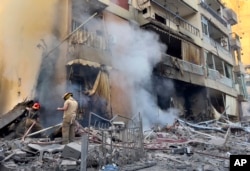Human Rights Watch on Thursday accused Israel of war crimes and crimes against humanity in its war against Hamas militants in Gaza, a conclusion Israel rejected.
The report said Israel, which has repeatedly displaced and relocated civilians, is “committing the war crime of forcible transfer,” and the actions “appear to also meet the definition of ethnic cleansing" in the areas where Palestinians will not be able to return.
"Human Rights Watch found that forced displacement has been widespread, and the evidence shows it has been systematic and part of a state policy. Such acts also constitute crimes against humanity," the report said.
In response, Israel accused the organization of using rhetoric that is "completely false and detached from reality."
The Israeli Foreign Ministry said that Israel's efforts are "directed solely at dismantling Hamas's terror capabilities and not at the people of Gaza, unlike Hamas, which uses civilians as human shields and embeds terror infrastructure within residential areas.”
"Israel views all civilian harm as a tragedy, while Hamas views all civilian harm as a strategy. Israel will continue to operate in accordance with the law of armed conflict," spokesman Oren Marmorstein said in a statement.
Hamas denies that it uses civilians as human shields or hides fighters and weapons in facilities such as hospitals and schools.
The law of armed conflict forbids the forcible displacement of civilian populations from occupied territory, unless necessary for the security of civilians or imperative military reasons.
Israel invaded the Gaza Strip last year after Hamas led a terror attack on communities in southern Israel, killing about 1,200 people, according to Israeli authorities, and abducting more than 250 as hostages, about 100 of whom are still in Gaza, a third of them believed to be dead.
Since then, the Israeli counteroffensive has killed more than 43,500 people, according to Gaza health authorities, and destroyed much of the enclave's infrastructure, forcing most of the 2.3 million population to move several times.
Hamas and Hezbollah have been designated as terror groups by the United States, Britain and other Western countries.
For the past month, Israeli troops have moved tens of thousands of people from areas in the north of the territory along the Mediterranean Sea as they sought to destroy Hamas forces the military says have been regrouping around the towns of Jabalia, Beit Lahiya and Beit Hanoun.
Human Rights Watch said the displacement of Palestinians "is likely planned to be permanent in the buffer zones and security corridors," an action it said would amount to "ethnic cleansing."
The Israeli military has denied seeking to create permanent buffer zones, and Foreign Minister Gideon Saar said on Monday that Palestinians displaced from their homes in northern Gaza would be allowed to return at the end of the war.
Human Rights Watch researcher Nadia Hardman, in a news release accompanying the group’s report, said, “The Israeli government cannot claim to be keeping Palestinians safe when it kills them along escape routes, bombs so-called safe zones, and cuts off food, water, and sanitation. Israel has blatantly violated its obligation to ensure Palestinians can return home, razing virtually everything in large areas.”
Hardman noted the report's findings are based on interviews with displaced Gazans, satellite imagery, and public reporting conducted until August 2024.
Airstrikes in Gaza, Lebanon
On the warfront, an Israeli strike on a home in northern Gaza killed three children, among at least six people killed in the territory, Palestinian medics said.
An airstrike hit the southern suburbs of Beirut on Thursday after an Israeli warning to evacuate parts of the Hezbollah bastion, Agence France-Presse reported.
Shortly before the strike, Israel had issued a warning to residents to evacuate their homes.
"You are located near Hezbollah facilities and interests against which the [Israeli military] will operate in the near future," army spokesman Avichay Adraee said in a post on X that included a map identifying buildings in the areas.
In a post on the Telegram messaging app Thursday, Israel Defense Forces said the air force struck and dismantled more than 140 Hezbollah launchers in southern Lebanon and had killed two battalion commanders and a company commander.
“Over the past week, the IDF eliminated over 200 Hezbollah terrorists in southern Lebanon from the air and ground,” the post stated.
On Wednesday, six Israeli soldiers were killed in combat near the border with Lebanon.
The soldiers "fell during combat in southern Lebanon," the army said in a statement. Their deaths mean 47 Israeli troops have been killed in combat with Hezbollah since September 30, when Israel sent ground forces into Lebanon.
The war spread to Lebanon in mid-September, after months of rocket fire from Hezbollah into Israel and drone and airstrikes by Israel's military in south Lebanon escalated. More than 3,200 Lebanese have been killed, most of them in the past six weeks.
Information from The Associated Press, Reuters and Agence France-Presse was used in this report.











